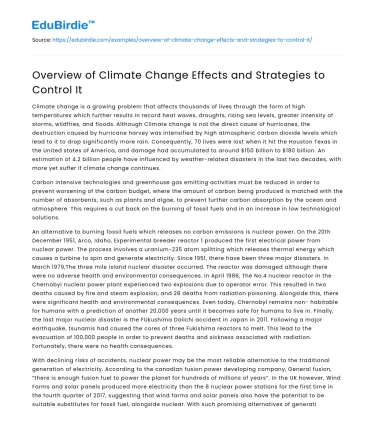Climate change is a growing problem that affects thousands of lives through the form of high temperatures which further results in record heat waves, droughts, rising sea levels, greater intensity of storms, wildfires, and floods. Although Climate change is not the direct cause of hurricanes, the destruction caused by hurricane harvey was intensified by high atmospheric carbon dioxide levels which lead to it to drop significantly more rain. Consequently, 70 lives were lost when it hit the Houston Texas in the United states of America, and damage had accumulated to around $150 billion to $180 billion. An estimation of 4.2 billion people have influenced by weather-related disasters in the last two decades, with more yet suffer if climate change continues.
Carbon intensive technologies and greenhouse gas emitting activities must be reduced in order to prevent worsening of the carbon budget, where the amount of carbon being produced is matched with the number of absorbents, such as plants and algae, to prevent further carbon absorption by the ocean and atmosphere. This requires a cut back on the burning of fossil fuels and in an increase in low technological solutions.
Save your time!
We can take care of your essay
- Proper editing and formatting
- Free revision, title page, and bibliography
- Flexible prices and money-back guarantee
An alternative to burning fossil fuels which releases no carbon emissions is nuclear power. On the 20th December 1951, Arco, Idaho, Experimental breeder reactor 1 produced the first electrical power from nuclear power. The process involves a uranium-235 atom splitting which releases thermal energy which causes a turbine to spin and generate electricity. Since 1951, there have been three major disasters. In March 1979,The three mile island nuclear disaster occurred. The reactor was damaged although there were no adverse health and environmental consequences. In April 1986, The No.4 nuclear reactor in the Chernobyl nuclear power plant experienced two explosions due to operator error. This resulted in two deaths caused by fire and steam explosion, and 28 deaths from radiation poisoning. Alongside this, there were significant health and environmental consequences. Even today, Chernobyl remains non- habitable for humans with a prediction of another 20,000 years until it becomes safe for humans to live in. Finally, the last major nuclear disaster is the FUkushima Daiichi accident in Japan in 2011. Following a major earthquake, tsunamis had caused the cores of three Fukishima reactors to melt. This lead to the evacuation of 100,000 people in order to prevent deaths and sickness associated with radiation. Fortunately, there were no health consequences.
With declining risks of accidents, nuclear power may be the most reliable alternative to the traditional generation of electricity. According to the canadian fusion power developing company, General fusion, “there is enough fusion fuel to power the planet for hundreds of millions of years”. In the UK however, Wind Farms and solar panels produced more electricity than the 8 nuclear power stations for the first time in the fourth quarter of 2017, suggesting that wind farms and solar panels also have the potential to be suitable substitutes for fossil fuel, alongside nuclear. With such promising alternatives of generating electricity with little or no carbon emissions, to combat climate change requires# a shift from our global reliancy on fossil fuels.
23% of C02 emission derives from transport. On average,a cars emit 5443kg (6 tons) of carbon dioxide every year. Electric cars on the other hand release 0 carbon emission directly, however powering them with electricity which can be generated from fossil fuels still contributes to carbon levels, due to electricity produced from fossil fuels and manufacturing of the battery. manufacturing emissions can be as much as 68% higher. However electric cars generate half the emissions of the average gasoline car which includes the manufacturing pollution, according to a study done by the Union of Concerned Scientists. Yet they produce some carbon emission, which is what we aim to mitigate. To reduce as much emission, we need to tackle electricity generation. Running electric vehicles and manufacturing the electric vehicle, specifically, the battery require electricity. Thus the emission ultimately depends on how electricity is generated. In countries with coal-intensive electricity generation, have similar lifetime emissions to the most efficient conventional vehicles whereas countries that decarbonise electricity generation, driving emissions will fall for existing EVs as electricity as fuel and manufacturing emissions will fall for new EVs as electricity is also required. Battery prices are falling, resulting in larger batteries to enhance driving ranges. Battery production emissions is thus reliant on the source of electricity. Renewable sources of energy will significantly reduce battery emissions,






 Stuck on your essay?
Stuck on your essay?

